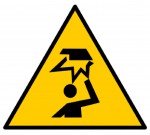Construction Safety Talk Series: Struck-By Hazards
 According to OSHA, Struck-By Hazards are defined as: Injuries produced by forcible contact or impact between the injured person and an object or piece of equipment. By identifying these hazards, and understanding how they happen, we can take steps to protect ourselves.
According to OSHA, Struck-By Hazards are defined as: Injuries produced by forcible contact or impact between the injured person and an object or piece of equipment. By identifying these hazards, and understanding how they happen, we can take steps to protect ourselves.
Types of Struck By Situations And What to Be Aware Of:
Flying / Falling Objects
- Flying object hazards include instances when a piece of material separates from a tool, machine, or other equipment.
- Falling objects from an elevation to a lower level, include instances where the injured person is crushed, pinned, or caught under a falling object, other than collapsing material or structures.
Swinging Objects
- When materials are mechanically lifted, they have potential to swing, twist, or turn. This movement can catch workers by surprise and they could be hit by the swinging load.
- Windy conditions are especially hazardous because the load will swing more. In addition to swinging, loads can slip from their riggings and strike workers.
Rolling Objects
- An object which is rolling, moving, or sliding on the same level at which the worker is located poses a great risk.
- This includes being struck or run over by a moving vehicle without being caught under it, or instances in which the worker is struck-by a sliding object or equipment on the same level.
How to Protect Yourself:
- Use the proper PPE.
- Ensure tools are in proper working order, with no loose attachments.
- Only use machinery that is properly guarded.
- Make sure that powder actuated fastener tools have proper backing .
- Set up barriers to deflect flying particles.
- Never use compressed air to clean or blow debris.
- Use toe boards to prevent items from dropping on workers below.
What is Your Employer’s Responsibility?
- Assess hazards that would affect the safe operation of hoisting equipment such as, power lines, ground firmness and levelness. Remove personnel that would be within the swing radius of items being hoisted.
- Erect barriers to mark the danger zone of a rotating equipment.
- Ensure that the equipment is in safe operating condition.
- Comply with all manufacturer procedures regarding equipment use, and attachments.
- Ensure loads are properly rigged by a qualified rigger.
- Ensure all equipment with obstructed view does not operate in reverse gear unless the equipment has a reverse signal alarm or a worker has been designated to signal when it is safe.
